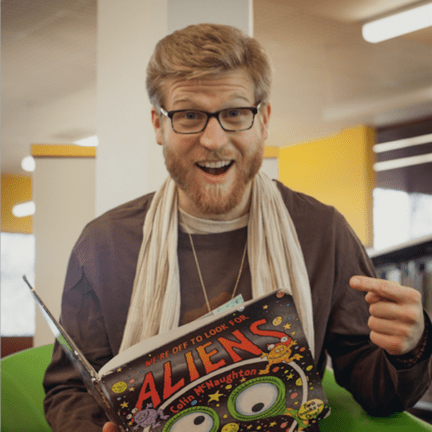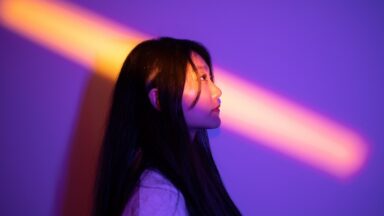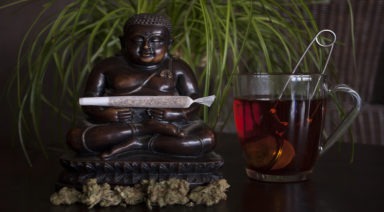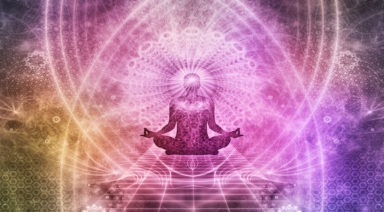Sacred Geometry in Nature
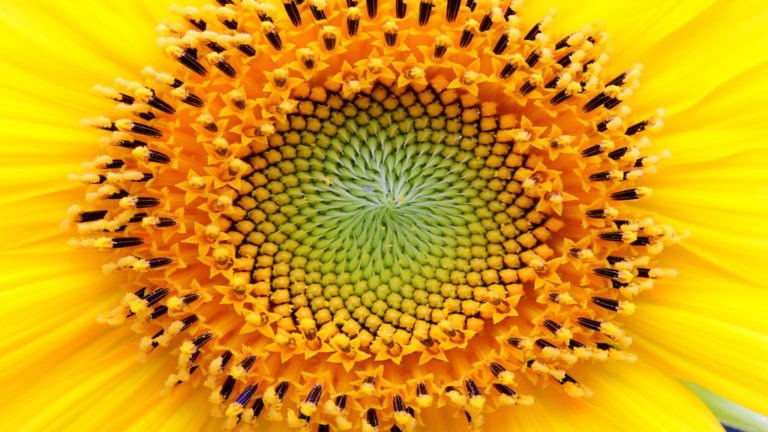
Sacred geometry is the nexus point between physics and mysticism. It is the realm where infinities live within finite forms, and the chaos of creation is brought to order.
The true beauty of sacred geometry is that it satisfies both the right and left brain. Elegant expressions of compelling proportional relationships simultaneously activate the intellectual and artistic functions, merging the rational with the abstract.
Sacred geometry arises from the desire to express philosophical truths through concrete means. It offers a scientific method for philosophical inquiry, complete with hypotheses, experiments, and repeatable results.
The best way to study the fundamental shapes of nature is to draw them yourself. In order to fully appreciate this article, I would encourage you to procure paper, pencil, compass and straight edge in order to perform at home the experiments here described.
Now, we will embark on a journey through creation as it arises in spheres, lines, and spirals. Fair warning: visceral engagement with these shapes can be irrationally rewarding; what begins as strictly formulaic may soon become more magical than ever expected.
Geometry as Nature’s Language
Geometry is not merely symbolic. It is nature’s way of solving problems with elegance and efficiency. The spiral of a galaxy mirrors the curl of a seashell, the hexagon of a honeycomb repeats in basalt columns, and the fractal branching of trees resembles lightning, rivers, and lungs. These recurring shapes reveal that nature builds through balance, proportion, and repetition.
In this sense, sacred geometry is also natural geometry, the mathematical language of creation itself. Patterns like the Fibonacci sequence and Golden Ratio govern growth and form, producing harmony in seashells, flowers, and snowflakes alike. Whether viewed through physics or philosophy, these patterns show that geometry connects all things, linking matter, energy, and consciousness through timeless order.
Seed, Flower, Fruit
By way of introduction, let us consider the life cycle of any fruit-bearing tree. Down from the ancestors, a seed reaches Earth, is buried, and germinates. Its cells divide, and the seed expands into a baby plant. A stable trunk grows up, and the tree eventually flowers, portending abundant fruits to come. When ripe, a fraction of the fruits fall to the earth. The flesh rots into compost that then feeds the new seeds now underground, just waiting for the day when the process starts anew.
This cycle ought to be painfully familiar to anyone with even the briefest human experience. Like plants, people are born, grow up, bear fruit, decay, and then die in order to feed that which is being born. This exact pattern is mirrored by the most fundamental processes of sacred geometry. In many ways, sacred geometry mirrors nature’s own mathematics. Every stage of growth, from seed to bloom, follows proportion and symmetry, the same structure seen in galaxies, shells, pinecones, and petals. Geometry turns chaos into harmony, forming a bridge between energy and matter.
The Geometry of Beginnings
Our journey begins with a single circle, which may also be drawn or imagined as a sphere. This is not yet a seed, but its mere potential. This first circle is an abstract concept that serves as the perpetual center point and container for all that comes next. If you are drawing along, this is a good time to bust out your compass and draw a circle — probably smaller than you might initially like — in the center of your paper.
The first movement on the road to fruition is duplication. Keeping the compass set to precisely the same radius, place its point anywhere along the circumference of the first circle and draw a second circle so that its edge passes through the center point of the first. You are now looking at a shape known as vesica piscis, the womb of creation, or literally, “the bladder of a fish.” This shape represents the union of opposites, the resolution of polarity. Two distinct entities overlap to create a unified space wherein a distinct third entity can arise. Need I explain why this shape is associated with femininity?
The vesica piscis also represents balance and proportion—the same mathematical harmony seen in natural systems. Its shape reflects the Golden Ratio (1.618), a universal constant appearing in countless living forms. These connections reveal that geometry doesn’t just symbolize creation—it describes how nature organizes itself. Consider where these relationships appear:
- Flower petals and seed patterns often follow Fibonacci spacing, optimizing light and space.
- Seashells and hurricanes form logarithmic spirals based on predictable geometric ratios.
- Cell division and water ripples recreate vesica-like intersections, showing how life literally builds from geometric relationships.
The Seed of Life and Cosmic Patterns
Here we have all the information needed to generate two equilateral triangles within the “womb,” where the circles overlap. Draw a line connecting the center points of the two circles. Now connect each center point directly to the point where the circles cross paths. You now have two equilateral triangles on either side of a horizontal (x) and an implied vertical (y) axis. From here, we can infer the existence of six equidistant points around one of the circles. A protractor is a useful tool to maintain precise measurements at this juncture, although a straight-edge is sufficient, and ultimately, a compass is all you need.
Now then, place the point of the compass on each of these new points and draw five more circles. You are now looking at something like this: This conglomeration of circles is called the Seed of Life. When someone mentions sacred geometry, the Seed arises first in my mind’s eye. It is extremely common to see derivations of this structure in visionary art, corporate logos, and new age tattoos.
Despite its pervasive usage, the shape is so fundamental to the structure of the cosmos that humans will never grow weary of its perfect harmonics. Would you or anyone deny that this pattern is infinitely pleasing? It is so interwoven into our lives that we may not even notice the depth of its symbolism. Where else do we encounter the concept of six encircling one?
The days of the week come to mind, based as they are upon the six days of creation, followed by a single day of rest. Similarly, there are six heavenly bodies (Mercury, Venus, Moon, Mars, Jupiter, Saturn) visible to the naked eye, all encircling the central sun. In addition, many traditions identify seven chakras, where the heart-center is encircled by three upper and three lower chakras. Likewise, there are seven perceptible colors in the rainbow, with green at the center and red or violet at either end of the spectrum.
There are plenty more of these examples available if you care to investigate further on your own, but evolution is ongoing, and so are we. These examples remind us that geometry acts as nature’s blueprint. Symmetry, proportion, and cycles repeat across every scale, from atomic bonds to planetary motion. The same geometry that governs sacred art also guides how trees branch, rivers divide, and clouds swirl.
Geometry as the Framework of Creation
Geometry is the silent architect of the natural world. From the symmetry of a snowflake to the balance of a pinecone’s spiral, it defines how energy finds equilibrium through structure.
- Symmetry ensures balance and stability in living and nonliving systems.
- Proportion determines harmony, appearing in everything from DNA strands to flower petals.
- Repetition creates fractal continuity, building infinite complexity from simple rules.
- The Golden Ratio serves as a universal guide for beauty, efficiency, and structural integrity.
Sacred geometry gives language to these invisible laws, revealing how creation reflects mathematical truth. It unites science and spirituality, showing that everything—from seeds to stars—follows the same sacred pattern of order, rhythm, and renewal.
From Seed to Flower
Once germinated, the seed becomes a plant and achieves its utmost beauty in the form of a flower. In sacred geometry, this is shown by adding another ring of six circles around the Seed, so that we now have twelve encircling one.
Just as a plant’s growth follows a predictable rhythm, geometry guides this unfolding process in nature. Circles, spirals, and hexagons emerge because they’re the most efficient ways for life to grow and organize itself. These same patterns form the foundation of sacred geometry, reflecting how mathematical order shapes both natural and spiritual creation.
(Remember: you can always add a circle around the outside to contain the entire shape. Just like the infinitesimally tiny dot at the very center, it doesn’t influence the overall energetics of the form.)
Is this a familiar shape? Does it have any applications in nature or human culture?
Common examples include the twelve signs of the zodiac that encircle our perspective here on Earth and the twelve hour-markers on the face of a clock. The famous Jesus of Nazareth is said to have had twelve disciples, the same way King Arthur led the twelve knights of the Round Table. We recognize twelve months in a year, and there is often a thirteenth full moon hidden within those solar months.
According to John Michell in How the World is Made, twelve “is the root number in the code of proportions that governs the solar system… In some remote, unknown age, the zodiac was divided into twelve sections so that the sun passed through one zodiacal house or sign in 2160 years, which is… the same as the diameter of the moon in miles…”
Far beyond any possibility of coincidence, such alignments reveal the divine intelligence inherent to creation. Such mysterious rationality and beautiful order cannot be the result of so many mere happy accidents.
This same harmony appears throughout nature’s geometry, revealing how creation balances beauty with efficiency:
- Spirals unfold in ferns, pinecones, and galaxies, expanding infinitely while maintaining proportion.
- Hexagons form in honeycombs and snowflakes, filling space with perfect precision.
- Fractals repeat in trees, rivers, coral, and lightning, demonstrating how complexity arises from simple repetition.
These forms remind us that sacred geometry is not confined to ancient symbols. It’s visible in every leaf, seashell, and snowflake, linking mathematical design to life’s ongoing evolution.
The fact that the Flower of Life is found carved or otherwise encoded into the remnants of ancient civilizations the world over only adds to the power of this image to inspire us toward further study of the fixed forms that give rise to reality as we know it.
Metatron’s Cube
In any healthy organism, flowering precedes the production of fruit. After the flower expresses its irrepressible beauty and fragrance, it wilts and all that energy redirects to generate the next generation.
Plants are super intelligent but basically immobile. As such, they have strategies to spread their seeds. Primary among these is to hide seeds within a delicious morsel so that some animal might pass by, consume the fruit and in its droppings, drop the seed in a far off the fertile ground. Thus the species is propagated, arriving in fresh territory already encased in the best kind of compost.
The fruit of one’s labor, loins, or karma refers to the tangible output of a period of incubation; to the cumulative and far-reaching effect of a collection of causes.
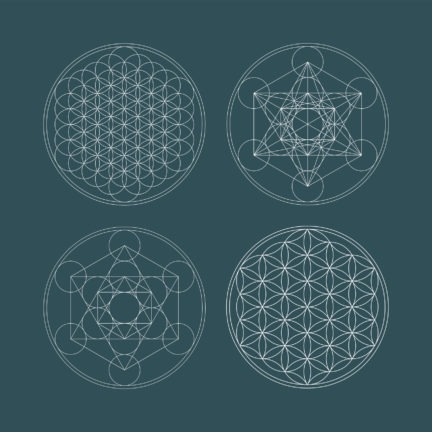
Metatrons Cube and Flower of life.
The fruit is the distillation of all previous efforts and growth. That which has been expanding now sheds superfluous forms to become highly concentrated in order to create new forms. To obtain excellent fruits, one must prune the tree.
The glorious complexity of the Flower is reduced in order to produce the Fruit of Life. This little death serves that which is being born.
Now simplified, the Fruit becomes the creative framework from which the infinite potential of Metatron’s Cube springs to life.
Home Geometers, if you haven’t already, draw a fresh Fruit of Life, separate from your other scribbles. Use a new paper if need-be.
Now, connect the center points of the thirteen circles that compose the Fruit, and you’ll discover a web of interlocking lines that are the two-dimensional representation of the three-dimensional polyhedra that are the complete structural basis for human experience. This multidimensional shape-stack is called Metatron’s Cube.
Esoterically, Metatron is an archangel, one of the energetic entities that oversee our particular corner of creation. Among the archangels, Metatron is understood to be the architect, the transcendent genius of shape and proportion. Metatron governs the specific logistics by which consciousness is able to take form.
Dear reader, at our shared level of experience, the most fundamental forms we can grasp are the five Platonic solids. The tetrahedron, octahedron, cube, icosahedron, and dodecahedron are the building blocks of our reality. These polyhedra are the only shapes in existence that have uniform numbers of sides, side lengths, and internal angles. They are the only perfectly symmetrical three-dimensional forms possible.
The five Platonic Solids correspond to the five elements and our five senses; they define the relationships between planetary orbits and atomic structures; they are the tools of Metatron; they are the vehicle whereby the Many arise from the One. The Platonic solids are the primary focus of a different article on the Gaia network.
Two Kinds of Spirals
If you’ve drawn along with us this long, congratulations — you have now sketched an outline of everything that is or could be. There is, however, one more dynamic we must acknowledge before reaching completion, and that is the quality of spin.
At each successive stage in the evolution from seed to flower, we simply added one more ring of circles around the center. This linear style of the spiral is called Archimedean, after the great Archimedes of Syracuse.
Archimedean spirals progress in a linear fashion, the way paper towel is wrapped around cardboard, or a rope is a coiled layer by layer. This is contrasted to a Phi, or Golden spiral, which expands proportionally according to the Fibonacci sequence. The Phi spiral is in fact far more common in nature, observable in phenomena such as whirlpools, tornadoes and spiral galaxies.
An excellent exercise to experience the difference between these two types of spirals is given on page 120 of A Beginner’s Guide to Constructing the Universe, by Michael Schneider.
In essence, the instructions are to cut two strips of paper and decide on a unit of measurement (inches, finger-breadths, it doesn’t matter). Beginning at one end of the first strip, measure and mark units of sequentially increasing value (1, 2, 3, 4…). For example, if the first section is one inch, then the second section is two inches, and so on. Then fold a right angle at each mark on this strip, and feel an Archimedean spiral unfold in your very own hands.
Do the same thing with the second strip of paper, except that here the length of each section is determined by the Fibonacci sequence (1, 1, 2, 3, 5, 8, 13…). Again, make a right angle at each mark and compare the results. When finished, you’ll have earned a direct and profound understanding of the two types of spirals that exist in nature.
Traces of the Creator
This essay tracks the organic evolution of potential energy into actuality using the simplest shapes available. These are the building blocks of sacred geometry.
These are concrete representations of abstract, otherwise inconceivable ideas. Simple shapes, lines, and curls generate a journey through the dimensions, perpetually approaching zero or infinity, the One and Many.
To discern the patterns by which creation unfolds and retracts is to approach the Creator directly. By participating in the process yourself, literally tracing the steps of the Creator, you have initiated yourself into a mystery tradition whose only limits are your own imagination.
This is truly universal knowledge, and according to Drunvalo Melchizedek, “It’s outside of any race or religion. It is a pattern that is intimately part of nature. If you go to distant planets where there is consciousness, I’m sure you’ll find the same image.”
Go on, then!
Discover the Seed of Life and Its Spiritual Meaning

The Seed of Life is a geometric figure composed of seven overlapping circles that form a symmetrical pattern. This symbol, present in ancient spiritual traditions, represents the foundation of creation and the link between geometry and universal consciousness. In this article, we explore the meaning of the Seed of Life, its connection to Sacred Geometry, and how to apply it in spiritual practice.
Table of Contents
- What Is The Seed Of Life?
- Spiritual Meaning Of The Seed Of Life
- How To Use The Seed Of Life In Spiritual Practice
- The Seed Of Life In Sacred Geometry
- History And Evolution Of The Seed Of Life
What Is The Seed Of Life?
The Seed of Life is a symbol of Sacred Geometry made up of seven circles arranged in a hexagonal structure. It originates from a single central circle, to which six equally sized circles are added, creating a harmonious and balanced pattern. This figure is considered the base for more complex geometric structures such as the Flower of Life and Metatron’s Cube.
Throughout history, various cultures have used the Seed of Life as a symbol of creation and the expansion of consciousness. It appears in temples, manuscripts, and sacred art in civilizations such as the Egyptian, Indian, and Mesopotamian. Its structure reflects the mathematical principles that govern nature—from crystal formation to the arrangement of petals in flowers.
In the series Sacred Geometry: Spiritual Science, available on Gaia, it is explored how these geometric patterns influence reality and the evolution of consciousness. Through the analysis of sacred figures, the series reveals the profound meaning of Sacred Geometry and its application in everyday life.
Spiritual Meaning Of The Seed Of Life
The Seed of Life is a symbol that represents the origin of existence and the interconnection of all things in the universe. Its geometric structure reflects the balance and harmony present in nature—from atoms to galaxies. In many traditions, it is considered a sacred map of creation that contains the fundamental patterns of reality. Studying and contemplating it helps understand the relationship between human consciousness and the cosmic order.
Energetically, the Seed of Life is associated with the expansion of consciousness and spiritual awakening. Its design is believed to activate the energy flow in the body and facilitate connection with higher levels of perception. In meditation, it is used to center the mind and harmonize emotional states, promoting inner peace. Many people use it as a tool for protection and balance on their spiritual path.
How To Use The Seed Of Life In Spiritual Practice
Incorporating the Seed of Life into spiritual practice can help strengthen the connection with creative energy and universal balance. Its geometric design acts as a channel for harmonization, protection, and personal development. Below are some ways to use it in daily life:
- Visual meditation: Observing the Seed of Life while meditating helps calm the mind and increase focus. Its geometric structure facilitates connection with higher states of consciousness and energetic balance.
- Energetic protection: Wearing this symbol as an amulet or placing images of it in personal spaces is associated with cleansing the auric field. Its vibration is believed to repel negative energies and bring emotional stability.
- Chakra activation: Placing the Seed of Life over the body’s energy centers can improve energy flow. It is used in practices such as Reiki or vibrational therapy to harmonize the energetic system.
- Mandalas creation: Drawing or coloring this geometric pattern is a therapeutic practice that stimulates creativity and introspection. This activity helps relax the mind and connect with the energy of the universe.
- Charging water and objects: Placing the Seed of Life near a container of water or on top of crystals is said to enhance their vibration. Many people use it to energize spaces and strengthen intention in spiritual rituals.
The Seed Of Life In Sacred Geometry
The Seed of Life is an essential pattern within Sacred Geometry, a discipline that studies the forms and proportions that structure reality. Its design is based on mathematical and geometric principles that reflect the order of the universe. It is considered a primordial symbol that represents the process of creation—from unity to the manifestation of matter.
This pattern is the foundation of more complex structures, such as the Flower of Life and Metatron’s Cube, used in various spiritual traditions. Its presence in ancient civilizations demonstrates its importance in esoteric knowledge and its relationship with universal energy. Exploring its meaning allows us to understand the connection between human consciousness and the architecture of the cosmos.
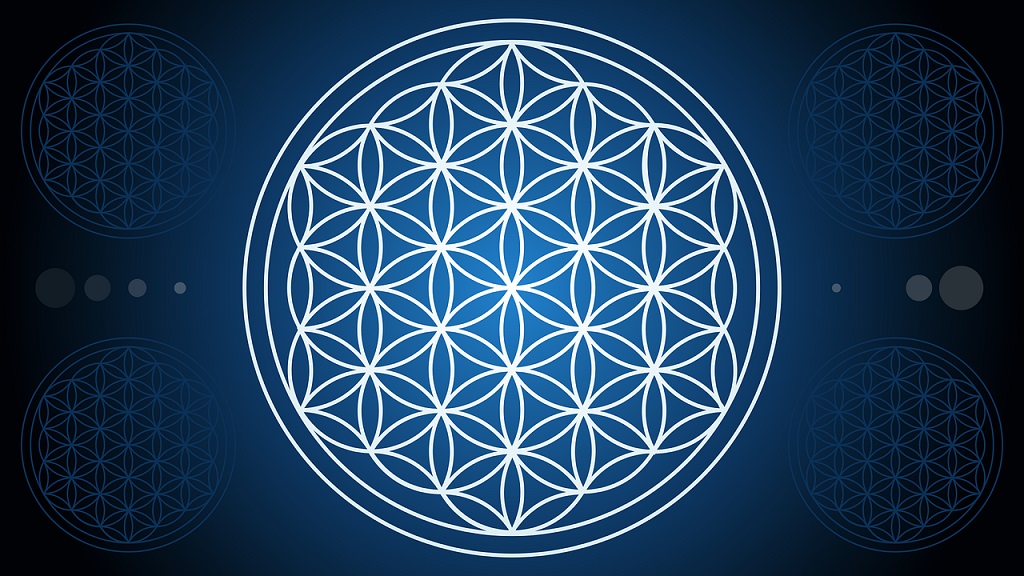
The Seed of Life is the core of the Flower of Life, a broader geometric pattern composed of multiple interconnected circles. While the Seed represents the first steps of creation, the Flower symbolizes the expansion of the universe and the interconnection of all existence. Its structure has been found in temples, manuscripts, and sacred art across various cultures around the world.
Within Sacred Geometry, the Flower of Life is considered a symbol of perfection and cosmic unity. It is said to contain the fundamental codes of reality, such as the Platonic Solids and the Golden Ratio. Studying and contemplating it allows access to profound knowledge about the nature of the universe and spiritual evolution.

Metatron’s Cube is a geometric figure derived from the Flower of Life, in which all the Platonic Solids can be found. Its connection with the Seed of Life lies in their shared origin within Sacred Geometry, where both represent different stages of the manifestation of reality. It is believed that Metatron’s Cube acts as a bridge between the physical and the spiritual worlds, being used in meditations and energetic practices.
This symbol is known for its ability to harmonize and balance energies, functioning as a tool for protection and spiritual activation. In many traditions, it is used to cleanse spaces, raise vibration, and access higher states of consciousness. Its relationship with the Seed of Life demonstrates how geometric patterns reflect universal principles of order and creation.
History And Evolution Of The Seed Of Life
The origin of the Seed of Life dates back to ancient civilizations that used Sacred Geometry in their architecture, art, and spiritual traditions. Examples of this symbol have been found in Egyptian temples, Hebrew manuscripts, and sacred constructions in India. Its presence across different cultures indicates a shared understanding of the universe’s fundamental patterns and their relationship with spirituality.
During the Renaissance, scholars such as Leonardo da Vinci studied Sacred Geometry and its applications in art and science. Da Vinci analyzed the Flower of Life and its internal forms, including the Seed of Life, recognizing its relationship with divine proportion. His work helped rekindle interest in these patterns and their influence on the structure of nature and human design.
Today, the Seed of Life continues to be studied and used in spiritual practices, energy healing, and conscious design. Its application in meditation, healing, and ecological architecture demonstrates its relevance in understanding balance and universal harmony. Its message of unity and creation continues to resonate, connecting people with the mathematical and spiritual essence of the cosmos.

